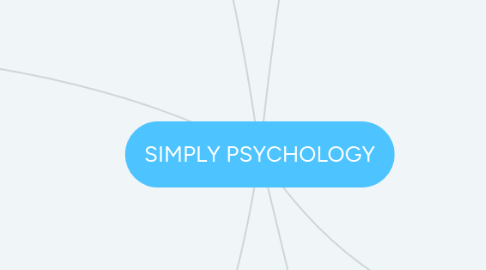SIMPLY PSYCHOLOGY
by Junric S. Cafeey

1. NATURE AND NURTURE
1.1. The nature versus nurture debate involves the extent to which particular aspects of behavior are a product of either inherited (i.e., genetic) or acquired (i.e., learned) influences.
1.1.1. The nature-nurture debate is concerned with the relative contribution that both influences make to human behavior, such as personality, cognitive traits, temperament and psychopathology.
1.1.2. Nature is what we think of as pre-wiring and is influenced by genetic inheritance and other biological factors. Nurture is generally taken as the influence of external factors after conception, e.g., the product of exposure, life experiences and learning on an individual.
1.1.3. nature nurture psychology
2. ANN OR ARTIFICIAL NEURAL NETWORK : Ann is the model of reasoning based on the human brain.
2.1. An artificial neuron network (ANN) is a computational model based on the structure and functions of biological neural networks. Information that flows through the network affects the structure of the ANN because a neural network changes - or learns, in a sense - based on that input and output.
2.2. ANNs are considered nonlinear statistical data modeling tools where the complex relationships between inputs and outputs are modeled or patterns are found.
2.3. ANN is also known as a neural network.
3. SOCIAL BRAIN
3.1. Social cognition in humans is distinguished by psychological processes that allow us to make inferences about what is going on inside other people—their intentions, feelings, and thoughts. Some of these processes likely account for aspects of human social behavior that are unique, such as our culture and civilization. Most schemes divide social information processing into those processes that are relatively automatic and driven by the stimuli, versus those that are more deliberative and controlled, and sensitive to context and strategy. These distinctions are reflected in the neural structures that underlie social cognition, where there is a recent wealth of data primarily from functional neuroimaging. Here I provide a broad survey of the key abilities, processes, and ways in which to relate these to data from cognitive neuroscience.
4. VIEWS OF HUMAN BRAIN
4.1. The cerebrum is the largest part of the brain, accounting for 85 percent of the organ's weight. The distinctive, deeply wrinkled outer surface is the cerebral cortex. It's the cerebrum that makes the human brain—and therefore humans—so formidable. Animals such as elephants, dolphins, and whales actually have larger brains, but humans have the most developed cerebrum. It's packed to capacity inside our skulls, with deep folds that cleverly maximize the total surface area of the cortex.
4.1.1. The cerebrum has two halves, or hemispheres, that are further divided into four regions, or lobes. The frontal lobes, located behind the forehead, are involved with speech, thought, learning, emotion, and movement. Behind them are the parietal lobes, which process sensory information such as touch, temperature, and pain. At the rear of the brain are the occipital lobes, dealing with vision. Lastly, there are the temporal lobes, near the temples, which are involved with hearing and memory.
5. THE TRIUNE BRAIN
5.1. The Triune Brain
5.2. Neuroscientist Paul D. MacLean formulated a model of the brain in the 1960s, detailed in his 1990 book The Triune Brain in Evolution, describing the brain in terms of three distinct structures that emerged along an evolutionary path. Although this model is a highly simplified explanation of brain activity and organisation, it provides an easy-to-understand approximation of the hierarchy of brain functions.
5.3. This system of the brain is responsible for the most basic survival functions, such as heart rate, breathing, body temperature, and orientation in space. Needless to say, functions like heart rate and breathing are rather important, and the control mechanisms in this part of the brain are rather consistent. It is important to recognise that the functions of this part of the brain will take precedence over other brain activity. For example, if you try to hold your breath (a prefrontal cortex-initiated activity), you will find that as carbon dioxide builds up in your bloodstream, this primitive part of your brain is going to want to take over and make you breathe again. Through training you may be able to increase your resistance to the basic urge to breathe, but inevitably you will eventually give in and take a breath. Such threats to survival are first addressed by the primitive brain—as illustrated in “peripheral shut-down”, where blood vessels are constricted on the periphery of the body in anticipation of physical trauma—and take precedence over other brain functions.
6. CONTEMPORARY ISSUES OF HUMAN BRAIN......
6.1. The other two forms of repurposing that are found in humans rely on social cognitive abilities. Cultural repurposing refers to the process by which cultural inventions--such as reading, musical forms, and belief systems--are acquired in a lifetime by co-opting preexisting brain circuits. "For example, we did not evolve to read. Instead, a growing body of research suggests that we read by repurposing neural machinery that evolved to process faces and objects," explains Parkinson.
6.2. Finally, instrumental repurposing happens not only within a lifetime, but on the fly. It is how we intentionally and creatively push our old evolutionary buttons to influence our own and others' behaviors. For example, the most effective way to elicit concern and help for problems that afflict many--such as poverty, hunger, and disease--is not a reasoned presentation of facts, but rather a depiction of a single, vividly identified victim. This may be in part because our social behavior was honed within small hunter-gatherer bands that lived together in close proximity, rather than a huge, anonymous, globally interconnected society. Such information has helped shape charitable donation campaigns and strategies for addressing indifference about issues such as global warming.
6.3. Considering these forms of repurposing can have wide-ranging implications for the world around us. "Understanding what is in our cognitive toolbox is a first step to understanding how we can most effectively use these tools to address modern problems that our brains did not evolve to solve," says Dr. Wheatley.

